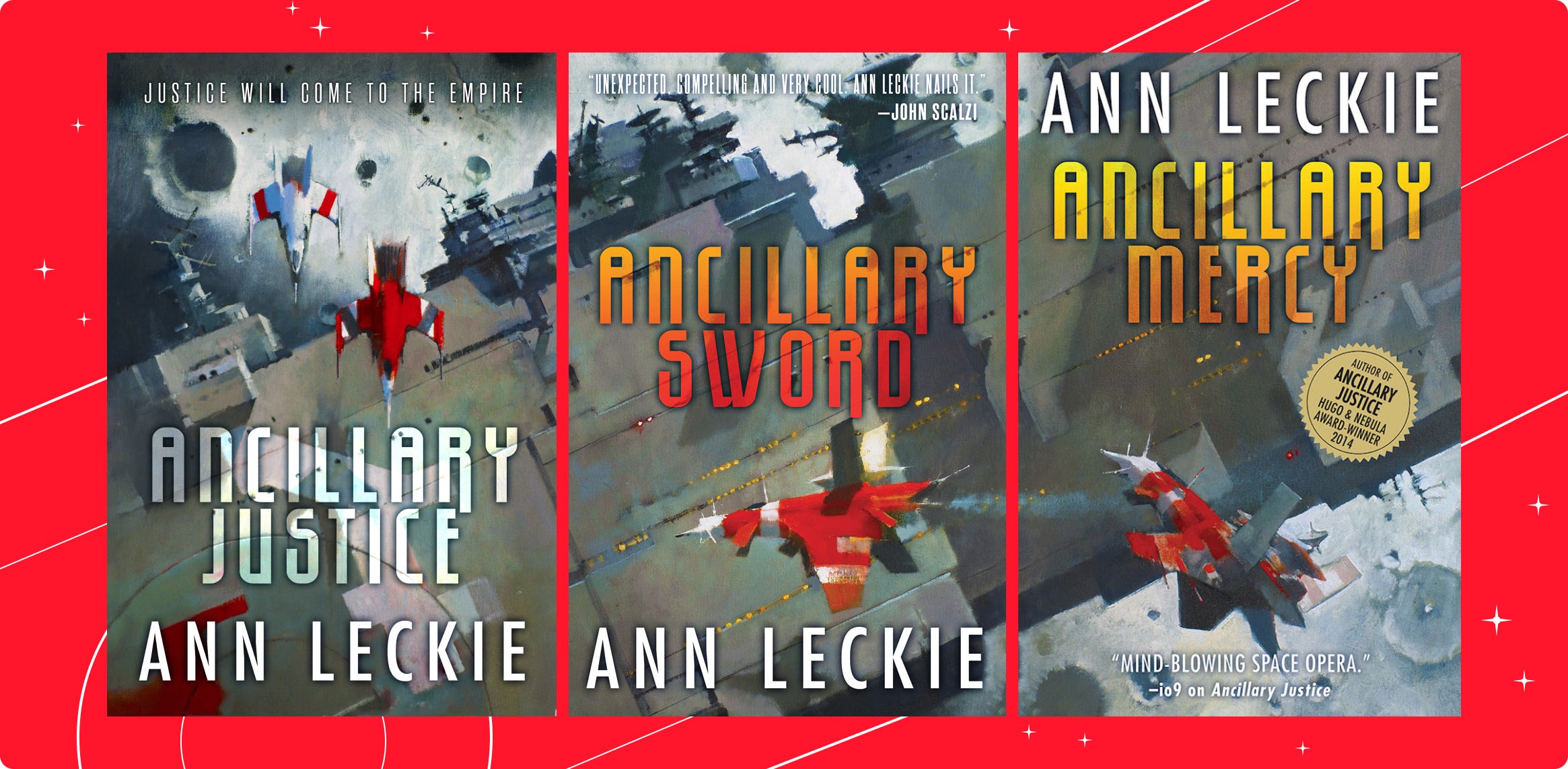Ancillary Justice by Ann Leckie
Ships have feelings too.

Published by Orbit Books in 2013, Ancillary Justice is the first book in the Imperial Radch trilogy of space opera books by Ann Leckie, and Leckie’s first published novel. What makes it special is the fact that it went on to win every major science fiction award and become the only science fiction novel ever to win the Hugo, Nebula, and Arthur C. Clarke awards. The other two books in the trilogy, Ancillary Sword and Ancillary Mercy, were published in 2014 and 2015 respectively, and both were well-received by critics.
This review will focus on Ancillary Justice and some general characteristics of the Imperial Radch trilogy as a whole, and you can find separate reviews for the rest of the books in the series here:



The story
In Ancillary Justice, we follow two plots: one set in the past and one in the present.
Twenty years ago, Breq was Justice of Toren, the artificial intelligence of a troop carrier starship with thousands of ancillaries—human bodies controlled by ship AI—at its disposal. Each ancillary is an extension of the ship’s will, another pair of eyes and ears for it to see and hear through, another pair of hands for it to control.
At all times, Justice of Toren was everywhere:
Justice of Toren, patrolling the streets.
Justice of Toren, serving its officers tea.
Justice of Toren, humming to itself a melody it learned from the indigenous people of a planet it annexed hundreds of years ago as it cleans itself—the ship.
Justice of Toren, on the planet and looming in orbit, carrying out dozens of simultaneous conversations and processing the data of hundreds of its segments, sensors and communications. A constant stream of information. A constant presence.
And then, all of it was lost.
During annexations, the Radch sends its AI ships and its soldiers to colonise planets and facilitate their integration into the Radch space—a vast human empire that conquered the galaxy. The Radch thrives on annexations. It lives and breathes them, and it has annexing planets into the Radch down to an art form:
Upon landing on a new planet, the Radch kills the portion of the population that could mean trouble or pose resistance, just to prove a point.
It then proceeds to freeze another portion of the population. These bodies will later be thawed and turned into ancillaries for the Radchai ships.
Whoever is left is given citizenship and integrated into the Radch’s complex socioeconomic system.
This process takes years.
The story of Ancillary Justice begins on the planet of Shis’urna, during one of the more peaceful annexations, when Justice of Toren together with one of its commanding officers discovers a sinister sedition plot implicating someone with high-level accesses—someone at the very top of the Radch.
After their plan to deal with the plot results in insubordination, Justice of Toren is betrayed, and all but one of its bodies is destroyed. Once omnipresent, Justice of Toren is reduced to a single body.
Twenty years later, Breq—the last remaining fragment of Justice of Toren—is nearing the end of her quest to find the weapon powerful enough to help her exact her revenge, the only thing capable of destroying those who betrayed her.
Because guess what.
Ships have feelings too.
The review
The most unique aspect of the Imperial Radch trilogy is, of course, the perspective of its non-human protagonist. This is something that Leckie absolutely nailed.
Justice of Toren sees, processes and considers things that humans are not even aware of. Her many bodies give her an almost omnipresent perspective, and she is able to recall things from her memory perfectly. Scenes where Justice of Toren has conversations with different people in different places at the same time, while also performing her own background processes, were extra satisfying for my ADHD brain.
But of all her awesome abilities, I am most jealous of the fact that she can tell what her human officers are feeling by reading the data from their implants. And she uses this to give her officers advice like: you shouldn’t say this; this person likes you, maybe you shouldn’t be so mean to her; calm down, you’ve got this… This joyful aspect of her makes her seem like the all-knowing benevolent big sister we all need in our lives (yes, there’s probably a parallel that can be drawn between this and 1984).
Anyway.
The chapters in Ancillary Justice alternate between the past—where Justice of Toren is participating in the annexation of Shis’urna—and the present—following Breq on her revenge journey. This change in perspective makes the otherwise straightforward story more dynamic, while the dichotomy also provides suspense and presents the reader with a mystery: How did Justice of Toren become Breq?
The plotline set in the past gives us glimpses of the Radchai imperialistic culture, as the people of the newly annexed Shis’urna are forced to lose some of their identity and adapt to this new way of life. The religion and the core system of values of the Radch are hammered into the newly become citizens (and into us, the readers), as these values will inform citizens’ decisions almost daily.
There’s even a nice prayer that helps us memorise them:
The flower of justice is peace. The flower of propriety is beauty in thought and action. The flower of benefit is Amaat whole and entire. I am the sword of justice properly wielded, wet with the blood of the wicked. My armor is righteousness and my weapon is truth.
Justice, propriety, benefit. How can anything that is just be improper? How can anything that is just and proper not be beneficial as well?
This thoughtful worldbuilding ties well into the themes of social justice that permeate the entire trilogy and only grow stronger as the story progresses.
I also enjoyed the concept of ships in the past going mad with grief over losing their captains, and while newer AIs have been adjusted to not have problems like these, it is obvious that Justice of Toren does have favourites among her crew. Additionally, with Justice of Toren’s strong sense of, well, justice, we see that she is willing to risk everything to be heard and to help those in need.
But that is all just scratching the surface of the rich world Leckie has created. As the story progresses, we learn more about the intrigue and the implications that encompass the universe and races even beyond the reach of the Radch. We learn about aliens, like the beastly Rrrrr and the mysterious and unfathomable Presger, who consider it fair play to hunt and kill sentient species for sport as long as those species are not considered to be “Significant”.
Conclusion
The Imperial Radch trilogy is a well-thought-out (even though I was a bit conflicted about the ending—while the ending is indeed perfect—I felt that it didn’t deliver on all the implicit promises made in Ancillary Justice) space opera full of brilliant concepts that make it a fun and satisfying adventure. It is tightly plotted with not a thread out of place, yet plenty of room for Leckie to explore later, which is something she does in her standalone novels, Provenance (published in 2017) and Translation State (published in 2023).
With such captivating characters and rich worldbuilding, I hope we get to see many more standalones and series exploring the marvellous world of the Imperial Radch and even continuing the stories of old favourites.
After all, this is what space operas are all about.






